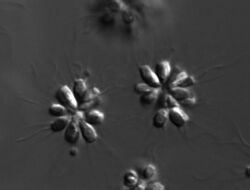Biology:Salpingoeca rosetta
| Salpingoeca rosetta | |
|---|---|
Error creating thumbnail: Unable to save thumbnail to destination
| |
| Scientific classification | |
| Domain: | Eukaryota
|
| (unranked): | Opisthokonta
|
| (unranked): | |
| Class: | Choanoflagellatea
|
| Order: | |
| Family: | |
| Genus: | |
| Species: | S. rosetta
|
| Binomial name | |
| Salpingoeca rosetta Dayel et al., 2011[1]
| |
| Subspecies or strains | |
| |
| Synonyms | |
| |
Salpingoeca rosetta is a species of Choanoflagellates in the family Salpingoecidae. It is a rare marine eukaryote consisting of a number of cells embedded in a jelly-like matrix. This organism demonstrates a very primitive level of cell differentiation and specialization. This is seen with flagellated cells and their collar structures that move the cell colony through the water.
Similar low level cellular differentiation and specification can also be seen in sponges. They also have collar cells (also called choanocytes due to their similarities to choanoflaggellates) and amoeboid cells arranged in a gelatinous matrix.
Unlike S. rosetta, sponges also have other cell-types that can perform different functions. Also, the collar cells of sponges beat within canals in the sponge body, whereas Salpingoeca rosetta's collar cells reside on the inside and it lacks internal canals. Despite these minor differences, there is strong evidence that Proterospongia and Metazoa are highly related.[citation needed]
Its genome has been studied as a model for Premetazoan evolution.[2] The genome is 55 megabases in size. Homologs of cell adhesion, neuropeptide and glycosphingolipid metabolism genes are present in the genome.
Reproduction cycle
S. rosetta has a sexual cycle during which it transitions between haploid and diploid stages.[3] When nutrients become limiting, haploid cultures of S. rosetta become diploid. This ploidy shift coincides with mating during which small, flagellated cells fuse with larger flagellated cells. Evidence has also been obtained for historical mating and recombination in S. rosetta.
S. rosetta can be induced to undergo sexual reproduction by the marine bacterium Vibrio fischeri.[4] A single protein of V. fischeri, EroS, fully recapitulates the aphrodesiac-like activity of living V. fischeri.
Colonial organization
S. rosetta was named for the rosette-shaped colonies formed by its cells.[5] The colonies are held together by adhesion molecules long thought to be found only in Metazoan organisms.[6] Additionally, recent evidence suggests that a bacterial sulfonolipid, called rosette inducing factor (RIF-1) and produced by Algoriphagus machipongonensis, triggers colony formation in S. rosetta.[7] The effect of RIF-1 on colony formation in S. rosetta has been suggested as an example of how interactions between bacteria and eukaryotes may have led to multicellularity in the latter.
References
- ↑ "Cell differentiation and morphogenesis in the colony-forming choanoflagellate Salpingoeca rosetta". Developmental Biology 357 (1): 73–82. September 2011. doi:10.1016/j.ydbio.2011.06.003. PMID 21699890.
- ↑ "Premetazoan genome evolution and the regulation of cell differentiation in the choanoflagellate Salpingoeca rosetta". Genome Biology 14 (2): R15. February 2013. doi:10.1186/gb-2013-14-2-r15. PMID 23419129.
- ↑ "Evidence for sex and recombination in the choanoflagellate Salpingoeca rosetta". Current Biology 23 (21): 2176–80. November 2013. doi:10.1016/j.cub.2013.08.061. PMID 24139741.
- ↑ "Mating in the Closest Living Relatives of Animals Is Induced by a Bacterial Chondroitinase". Cell 170 (6): 1175–1183.e11. September 2017. doi:10.1016/j.cell.2017.08.005. PMID 28867285.
- ↑ "Multicellular development in a choanoflagellate". Current Biology 20 (20): R875-6. October 2010. doi:10.1016/j.cub.2010.09.014. PMID 20971426.
- ↑ "Evolution of key cell signaling and adhesion protein families predates animal origins". Science 301 (5631): 361–3. July 2003. doi:10.1126/science.1083853. PMID 12869759. Bibcode: 2003Sci...301..361K.
- ↑ "A bacterial sulfonolipid triggers multicellular development in the closest living relatives of animals". eLife 1: e00013. October 2012. doi:10.7554/eLife.00013. PMID 23066504.
External links
- -->
Wikidata ☰ Q42266354 entry
 |


